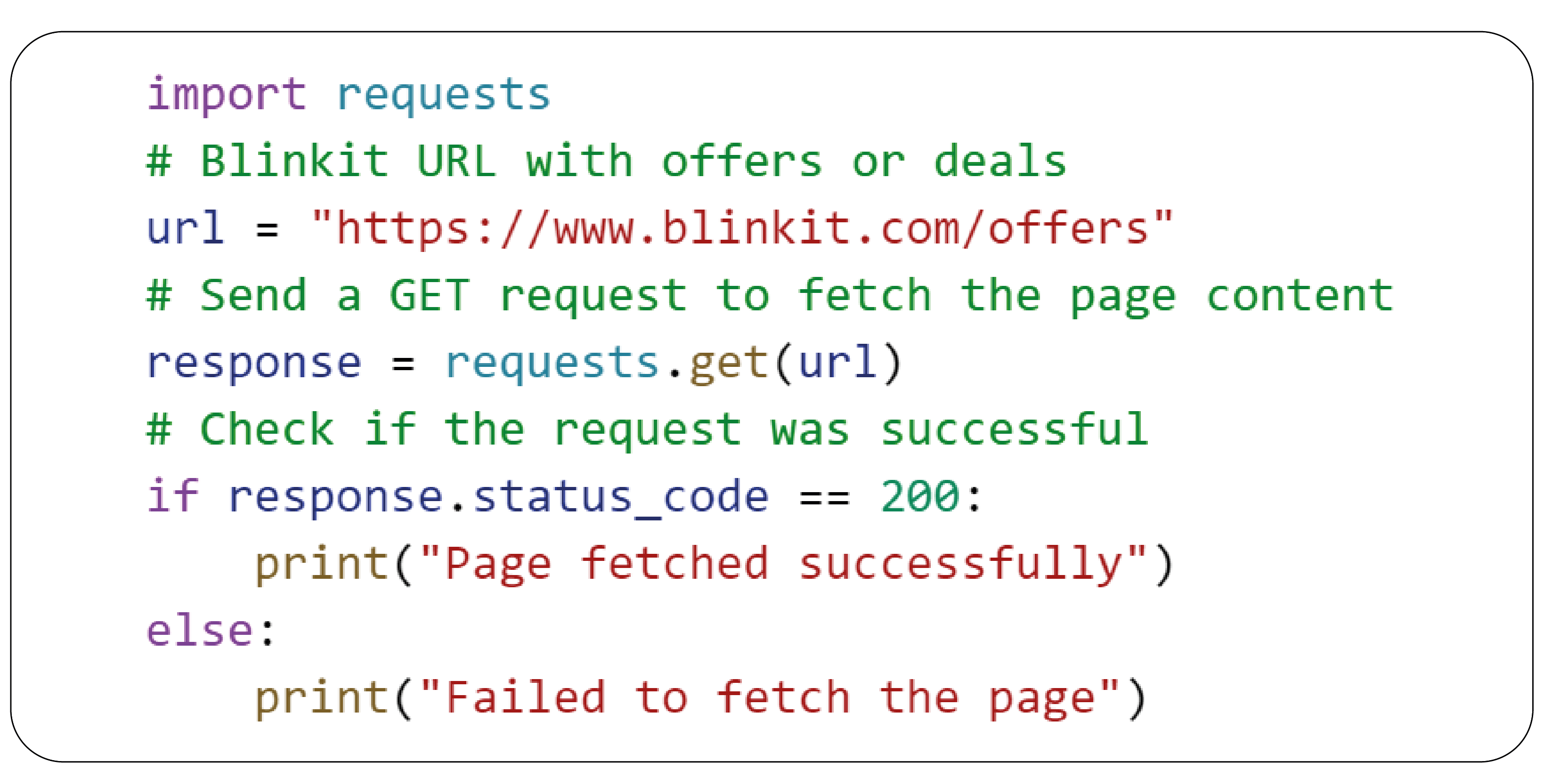
In today’s fast-paced e-commerce environment, extracting data from platforms like Blinkit can give businesses a significant edge. Blinkit, a leader in quick-commerce (q-commerce), offers a variety of promotional deals and discounts to customers, making it an ideal target for data scraping. Web scraping Blinkit offers with Python enables businesses to access real-time data on the latest deals and offers, offering valuable insights into consumer trends and pricing strategies. By scraping Blinkit’s deals and discounts, companies can fine-tune their pricing models, track competitor offers, and enhance marketing efforts. Scrape Blinkit deals and discounts to gather valuable data to inform promotions, optimize inventory, and improve customer targeting. This article will guide you through the steps of real-time Blinkit offer data scraping, using Python tools and libraries like BeautifulSoup, Selenium, and Requests to help automate the extraction process and deliver actionable insights for e-commerce businesses.
Why Scrape Offer Details from Blinkit?

Before diving into the technical details, let's first understand why businesses would want to scrape Blinkit for offers:
1. Real-Time Data: Blinkit frequently updates its offers, making it essential for businesses to stay on top of these real-time changes. Scraping offers from Blinkit ensures businesses have access to the latest deals, discounts, and promotions. By automating the process through Python scripts for Blinkit data extraction, companies can collect data in real-time, enabling them to react promptly to the latest market trends and maintain a competitive edge. This continuous flow of updated information is invaluable for crafting dynamic pricing strategies and staying ahead in the market.
2. Competitive Intelligence: Scraping Blinkit’s platform allows businesses to analyze competitors’ deals, promotions, and pricing strategies. Extract Blinkit discount details data to track competitors’ promotional patterns, identify seasonal trends, and monitor their discounting tactics. This allows for better strategic planning, as companies can adjust their offers and promotions based on competitive data. Analyzing Blinkit price and offer data collection helps businesses understand what works in the market, positioning them to refine their pricing strategies effectively.
3. Pricing Optimization: Offers and discounts on Blinkit are often associated with specific product categories. By scraping Blinkit, businesses can track fluctuations in these offers and better understand how discounts are structured within different product segments. Extract Blinkit Grocery & Gourmet Food Data to make informed decisions about their pricing models, ensuring their offers are competitive. Optimizing pricing becomes easier when businesses have real-time data to adjust their promotions and attract more customers, keeping them ahead of the competition.
4. Personalized Marketing: Data collected from Blinkit’s promotions can be used to drive highly targeted marketing campaigns. By scraping Blinkit’s deals and offers, businesses can personalize their marketing efforts to highlight similar offers to their customer base. With access to real-time promotional data, businesses can strategically tailor their campaigns based on current market trends, helping them increase sales and customer engagement. Extract Blinkit discount details data and integrate it into their marketing strategy to create relevant, timely promotions that speak directly to customer needs, boosting conversion rates and fostering customer loyalty.
Setting Up the Python Environment

To scrape offer details from Blinkit using Python, you will need a few essential libraries and tools:
1. Python: Ensure that Python 3.x is installed on your system.
2. BeautifulSoup: This library helps parse HTML and extract relevant data.
3. Requests: Requests is a simple HTTP library for requesting web pages.
4. Selenium: For dynamic pages that rely on JavaScript to load content, Selenium can simulate browser interactions.
5. Pandas: Useful for storing and manipulating the scraped data.
6. JSON: Often used to store or manipulate scraped data.
Step-by-Step Process for Scraping Blinkit Offers
1. Install Required Libraries

Before you can start scraping, you need to install the necessary libraries. Open a terminal or command prompt and run the following commands:
If you plan to scrape data from pages that use JavaScript to load content, install the following to interact with the page using a real browser:
pip install webdriver-manager
2. Send a Request to the Blinkit Website
The first step in any web scraping task is to send an HTTP request to the website. With the requests library, you can fetch the HTML content of Blinkit’s webpage.

3. Parse the HTML Content with BeautifulSoup
After fetching the page content, we need to parse it to extract relevant information like offer titles, discounts, product details, etc. BeautifulSoup makes this easy by parsing the HTML and allowing you to search for tags and elements.

4. Extract Offers from the HTML
Once the page is parsed, we can start extracting the offer details. Typically, e-commerce platforms display offers inside specific HTML elements such as div, span, or a. You'll need to inspect the Blinkit page to identify these elements.
For instance, assume the offers are within a div with a class name offer-details:

5. Handling Dynamic Content with Selenium
Some pages, including those on Blinkit, might dynamically load content using JavaScript. The above method may not work as expected in such cases because the content is loaded after the initial page load. Selenium can simulate browser actions, allowing you to wait for the content to load and then scrape it.

6. Store Scraped Data in a Structured Format
After scraping the offer details, storing them in a structured format like CSV, JSON, or Excel for further analysis is crucial. Here’s how to store the scraped data in a CSV file using Pandas:

7. Handling Anti-Scraping Measures
Some websites, including Blinkit, implement anti-scraping measures such as CAPTCHAs or IP blocking. Here are a few techniques to handle these challenges:
 User-Agent Rotation: Change the user-agent string for each request to mimic different browsers and avoid detection.
IP Rotation: Use proxies to rotate IP addresses and prevent your scraper from getting blocked.
CAPTCHA Solvers: If Blinkit uses CAPTCHA, you may need to integrate CAPTCHA-solving services such as 2Captcha or AntiCaptcha.
User-Agent Rotation: Change the user-agent string for each request to mimic different browsers and avoid detection.
IP Rotation: Use proxies to rotate IP addresses and prevent your scraper from getting blocked.
CAPTCHA Solvers: If Blinkit uses CAPTCHA, you may need to integrate CAPTCHA-solving services such as 2Captcha or AntiCaptcha.
Conclusion
Scraping offers details from Blinkit using Python, which can provide valuable insights for businesses looking to enhance their e-commerce strategies. By leveraging tools like requests, BeautifulSoup, and Selenium, businesses can extract the latest promotional deals and gain a competitive edge. With the data collected, companies can fine-tune their pricing models, create more targeted marketing campaigns, and drive higher sales. This can be particularly beneficial when working with data like Blinkit Grocery Dataset, including product offers, pricing, and real-time discounts.
Additionally, businesses can utilize Blinkit - Product Intelligence Product Dataset from India, to track trends and offers in the grocery sector. With data on Blinkit's grocery promotions, companies can optimize their product offerings and ensure they remain competitive. Through Web Scraping Grocery & Gourmet Food Data, businesses can analyze product details, track changes in pricing strategies, and adapt quickly to new consumer behaviors and market trends.
However, staying mindful of the legal and ethical implications of web scraping is essential. Always ensure compliance with Blinkit’s terms of service and privacy policies, and use scraping tools responsibly. By automating the process of scraping Blinkit’s offers, businesses can gather real-time data and respond swiftly to market changes, keeping their competitive advantage intact.
At Product Data Scrape, we strongly emphasize ethical practices across all our services, including Competitor Price Monitoring and Mobile App Data Scraping. Our commitment to transparency and integrity is at the heart of everything we do. With a global presence and a focus on personalized solutions, we aim to exceed client expectations and drive success in data analytics. Our dedication to ethical principles ensures that our operations are both responsible and effective.



























.webp)
-01.webp)
.webp)

.webp)